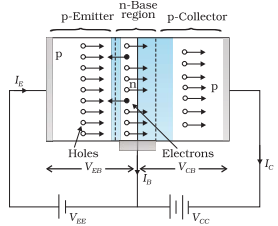
A brief description of the three segments of a transistor is given below:
- Emitter: This is the segment on one side of the transistor. It is of moderate size and heavily doped. It supplies a large number of majority carriers for the current flow through the transistor.
- Base: This is the central segment. It is very thin and lightly doped.
- Collector: This segment collects a major portion of the majority carriers supplied by the emitter. The collector side is moderately doped and larger in size as compared to the emitter.
p-n-p Transistor:
From given fig., we can see that, the emitter-base junction is forward biased. Collector-base junction is reverse biased.

The resistance of emitter-base junction is very low so the voltage of Vee (Veb) is quite small (i.e., 1.5 V). the current in p-n-p transistor is carried by holes and at the same time their concentration maintained But in external circuit the current is due to flow of electrons.
![]()
Ie = emitter current
Ib = base current
Ic = collector current
n-p-n Transistor:
In the base, Ie and Ic flow in opposite direction. In this transistor, the emitter-base junction is forward biased and its resistance is very low. So, the voltage of VEE is quite small. The collector base junction is reverse biased. The resistance of this junction is very high. So, the voltage of VCC (VCB) is quite large (45 V). In n-p-n transistor, the current is carried inside as well as in external circuit by the electrons. Thus, in this case also,

![]()
In the base, Ie and Ic flow in opposite direction.

